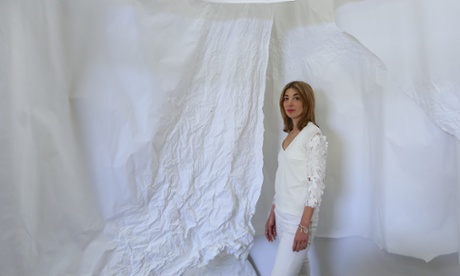
In 2003, Mira Calix premiered her groundbreaking musical composition Nunu in London. On stage at the Royal Festival Hall were an orchestra (no surprises there), Calix (playing electronics), and then the insects – both live and recorded. The piece revolved around wasps. Calix used them like a string quartet.
Their songs were taped in an anechoic chamber at the Natural History Museum of Geneva. In this vault, which is free of echo, Calix sourced the kind of sounds that human beings are normally unable to pick up. She expounds wide-eyed: “I heard amazing things like ants walking or moths coming up out of their pulps.”
Nature’s minuscule moments became the essence of Nunu. Calix placed live cicadas and crickets in a fish tank on stage with cameras trained on them. Projections were broadcast to the audience on a giant screen. This caused some freak-outs (one woman listened to the entire show with her eyes closed) but to deter any whispers of insect cruelty, Calix hired a handler to ensure the creatures had a heating pad, water, and lettuce. “It’s all about the insects,” she insists, even now. “They totally steal the show every time.”
Gimmicky maybe. But Calix, 39, is much more than pyrotechnics – or pests. Like the Heston Blumenthal of the music world, she creates new boundaries, rather than working within old ones. Nunu summons up sounds of summer: heaving vegetation and bustling creeping, crawling, flying creatures oblivious to the human world. It also has staying power – 10 years on, the show continues to travel the world.
Now the UK-based composer, artist, and electronic musician (she has toured with Radiohead) is in Sydney to premiere Inside There Falls, a vast paper maze. The flagship Sydney festival piece is on show in the cavernous arches of the former 19th century railway carriage and blacksmith workshops that is Carriageworks gallery.
I meet Calix early one morning on an unseasonably chilly day in late October. Small and wiry, bursting with enthusiasm and warmth, she plops herself on the sofa at Carriageworks’ modish cafe and orders a much-needed coffee (having just flown in from London). Despite her jetlag and the windy weather, she is spunky and sunny.
This is a globe-trotting artist who is unlikely to throw tantrums. “Art isn’t just for arseholes,” Calix has told media in the past. It should be for everyone. To this end, in 2012, Calix erected Nothing is Set In Stone on a windswept, grassy hill in London.
The proud structure – a singing stone shaped like a mammoth egg – was a tribute to music and pagan forms and the wonderment of creation. Made up of thousands of round stones, it emitted a melody that shifted and morphed depending on who walked past. London’s mayor, Boris Johnson, said at the time: “Mira Calix has managed to wrest not blood, but music from a stone.”
Now she is constructing palaces from paper. Inside There Falls, taking over one whole wing of Carriageworks, includes cascading paper streams descending from the roof, walls alive with music and movement, dancers (performing dreamy, abstract choreography by Sydney Dance Company’s Rafael Bonachela), and a giant ball slowly disintegrating onto a white altar piled with sand-coloured cinnamon. The whole structure spans 32 metres and is entirely free to visit.
It was 2011, as winter released its grip on Calix’s adopted home of Suffolk, England (she was born in South Africa), that she received an email in the early hours from a stranger. Sydney author Brett Clegg sent her a piece of writing and asked her to read it. It was a stream of consciousness; as he explained, an exploration of the origins of the mermaid myth. As Calix later wrote, when she opened the mail, “the words came tumbling out. Archipleago, cinnamon and marigold, Words I love, falling like spring downstairs, rhythmically and percussively.”
Calix read the letter once, read it again two weeks later, and did not pick it up again for months. It was to become the source of Inside There Falls. In the show, a female voice whispers in and out of the paper walls, lulling and rhythmic. “It’s not something I slaved over,” she notes. “Over six months, it just started to create this form. It just is. And I don’t question it. It’s just what it had to be.”
Or not be. Central to the work is disintegration. Change – whether imperceptible and gradual or conspicuous and fast – fascinates Calix, perhaps as a result of living near the sea where the tides have sculpted cliffs over millennia. “Everything in [the work] is rebuilding a story and I wanted one object that is destroying a story,” she enthuses, leaning forward. She laughs. “I sound like a lunatic again.”
This integral element – the decaying heart, if you will – became the hanging ball in the piece, fashioned from oak gall ink, the type used in medieval manuscripts. Acidity in the deep purple-black ink, made from iron salts and tannic acids drawn from vegetables, effectively corrodes the paper it is written on.
In this way, Inside There Falls, made of paper, relates to Nothing is Set In Stone, made of stone. Both ultimately erode. But for Calix the practical side of art is as enticing as the finished product. She shipped a kilometre and a half of paper from a barn in Suffolk to Sydney for Inside There Falls, and, to make the ink ball, spent hours with a book conservator learning the craft of concocting gall.
“I do believe that making art is 49% problem solving. You are literally figuring out whether it’s something technical or practical, emotional or narrative, or whether it’s conceptual,” she says. And the other 51%? She thinks. “It’s the thing that none of us know how to put into words.”
• Inside There Falls is at Carriageworks, Sydney until 17 January. Sydney festival 2015 runs from 8 to 26 January at venues citywide. Find all Guardian Australia’s coverage here

